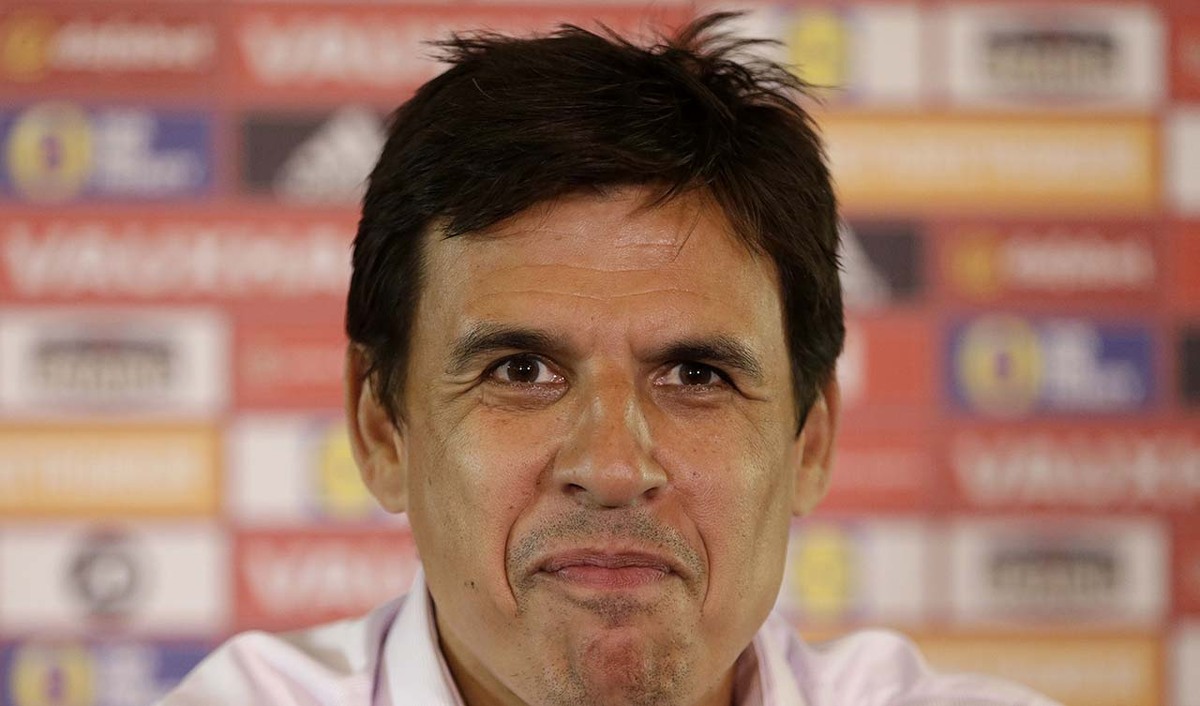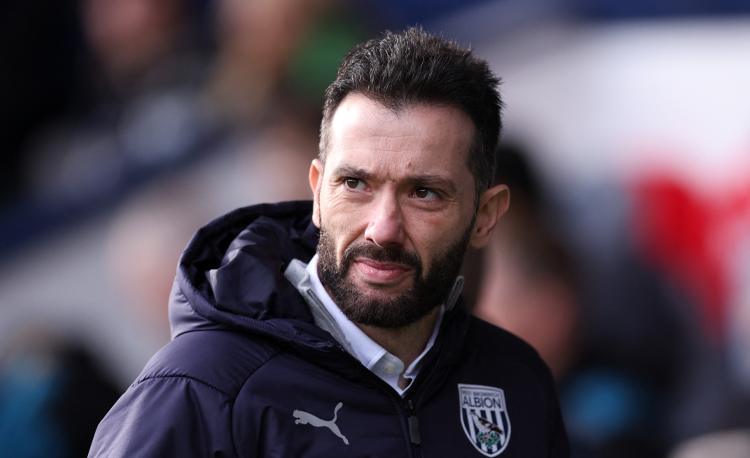You are viewing 1 of your 1 free articles
Counter-attacking
Use this attack versus defence session to create a variety of situations for players to work on quick attacks and combination play with an end product.
| Area | Full pitch |
| Equipment | Balls, bibs, cones, 2 full size goals |
| No. of Players | 20 players + 2 goalkeepers |
| Session Time | Total: 20mins |
We originally used this session to work on defending a counter-attack when playing with a back three. But it has since evolved into an attack versus defence session because it successfully creates so many situations for players to work on quick attacks and combination play with an end product.
Players find this session engaging because it is very real and focuses on counter-attacking, a part of the game that is becoming more vital to the team and more influential on results.
From a physical perspective, we find that players work in much the same way they would in a match, with high levels of intensity and extensive running for the attacking players.
We like to do this drill once a week. It takes place on a day when we want to give the players a physical hit in a very game-related manner. We usually run it three days before a match (MD-3).
What do I get the players to do?
We set up in the space between penalty areas on a full size pitch, with a goal at each end and an 18-yard zone marked out in front of each goal. We are using two sets of three defenders and three sets of four attackers. Each set of attackers has a designated centre forward. It’s a wave drill and only one set of defenders and one set of attackers are active at a time, with the rest waiting for their turns to go. We are also using two crossers, one on each side of the pitch in an unopposed channel.
We begin the drill with a pass from the server to one of the three attackers who start in the 18-yard area in front of their own goal. The receiving attacker then passes to one of the team mates on either side of him. This pass allows time for their centre forward, who starts off the pitch at the other end, to move onside by running between the opposition defenders, as shown [1a]. Once onside, the centre forward receives a long forward pass from his team mate. The three attackers then support the pass, creating a 4v3 attacking overload. The forwards must try to score as quickly as possible.
1a
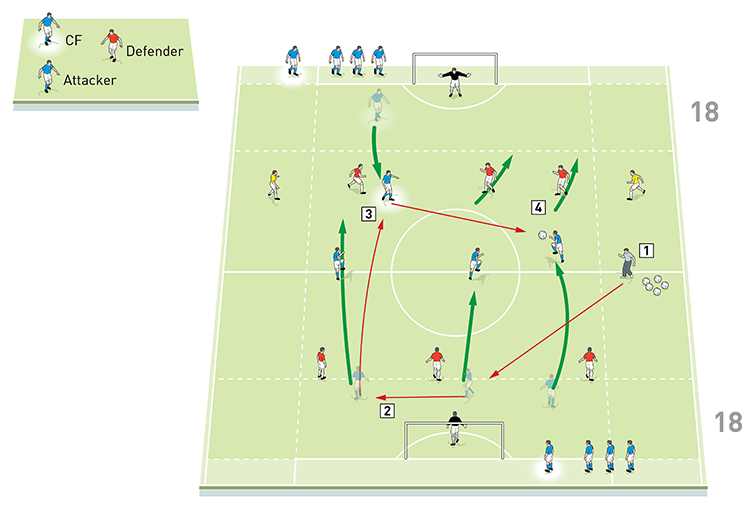
2. The receiving attacker then passes to one of the team mates either side of him
3. The centre forward moves onside by running between the defenders and receives a forward pass from his team mates
4. The three attackers support the pass to the centre forward, creating a 4v3 attacking overload. They must try to score as quickly as possible
On completion of the first attack, all the players come back out of the 18-yard zone and the attackers receive another ball from the server, as shown [1b]. This time, they must play it wide to either of the crossers in the unopposed channels. The crosser must either cross first time, take the ball past the 18-yard line to cross, or check back to deliver a cross.
1b
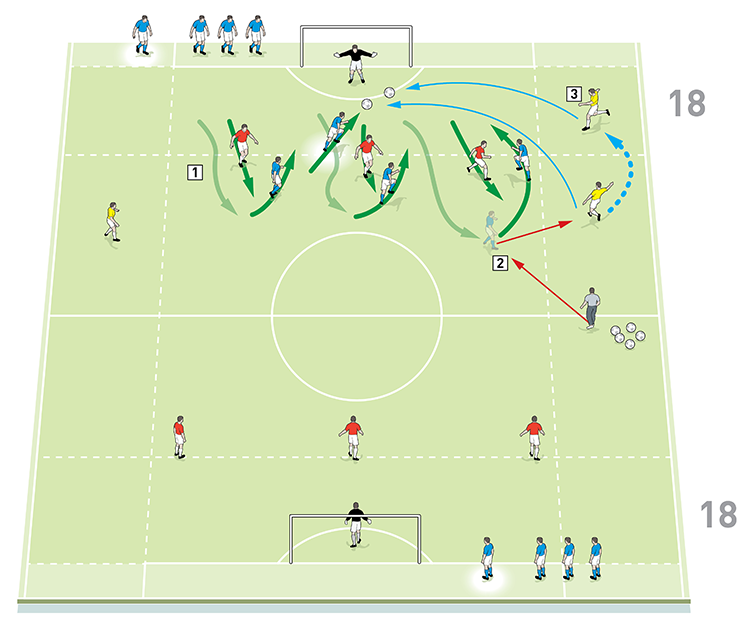
2. The server plays the next ball in. The attackers must pass it wide to either of the crossers
3. The crosser can cross first time, or take the ball past the 18-yard line to cross. Both options are shown here
On completion of the second attack, all the players must again come back out of the 18-yard zone and the attackers receive a third ball from the server, as shown [1c]. This time they should attack centrally and they have a limit of seven seconds to try to score.
1c
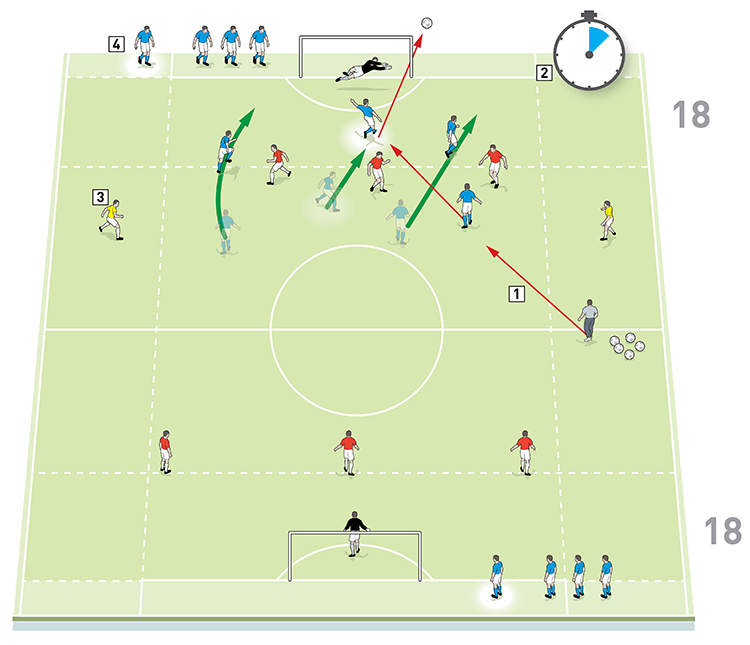
2. For the third attack, players should attack centrally. They have time limit of just seven seconds
3. On completion of the third attack, the blues receive a fourth ball from the server and must attack via the crosser that wasn’t used in the second attack
4. After the fourth ball goes dead, a new wave of players step in to attack the defenders at the other end, repeating the same four attacks
On completion of this third attack, the players again come back out of the 18-yard zone and the attackers receive a fourth and final ball from the server. This time they must pass to the other crosser and then attack in the same manner as before.
After the completion of the fourth and final attack, the next set of attackers must step in straightaway. They receive their first ball from the server and attack the fresh defenders guarding the opposite goal, looking for their centre forward at the other end to get onside to receive a pass. The two crossers must switch to the channels in the other half to attack that goal.
Before playing the starting pass for each attack, it is very important the server allows the attackers to retreat back past the 18-yard line.
We work on four blocks of four minutes. This achieves the physical targets that we aim for.
How do I progress the session?
We can progress the session by putting a time limit on the attackers, to make sure they attack quickly and with purpose. Another way is to introduce a defender from the other end of the pitch to put pressure on the attackers from behind.
What are the key things to look out for?
We want see a good defensive balance, with one defender engaging the ball and the other two defenders taking effective covering positions. Communication is key to this.
The speed of attack is also important and it is vital that, on transition, the counter-attack is quick and direct.
Related Files
Editor's Picks
Deep runs in the final third
Using the goalkeeper in build-up play
Pressing principles
Intensive boxes drill with goals
Penetrating the final third
Creating and finishing
My philosophy
Pressing initiation
Compact team movement
Coaches' Testimonials

Alan Pardew

Arsène Wenger

Brendan Rodgers

Carlos Carvalhal

José Mourinho

Jürgen Klopp

Pep Guardiola

Roy Hodgson

Sir Alex Ferguson

Steven Gerrard
Coaches' Testimonials

Gerald Kearney, Downtown Las Vegas Soccer Club

Paul Butler, Florida, USA

Rick Shields, Springboro, USA

Tony Green, Pierrefonds Titans, Quebec, Canada
Join the world's leading coaches and managers and discover for yourself one of the best kept secrets in coaching. No other training tool on the planet is written or read by the calibre of names you’ll find in Elite Soccer.
In a recent survey 92% of subscribers said Elite Soccer makes them more confident, 89% said it makes them a more effective coach and 91% said it makes them more inspired.
Get Monthly Inspiration
All the latest techniques and approaches
Since 2010 Elite Soccer has given subscribers exclusive insight into the training ground practices of the world’s best coaches. Published in partnership with the League Managers Association we have unparalleled access to the leading lights in the English leagues, as well as a host of international managers.
Elite Soccer exclusively features sessions written by the coaches themselves. There are no observed sessions and no sessions “in the style of”, just first-hand advice delivered direct to you from the coach.
